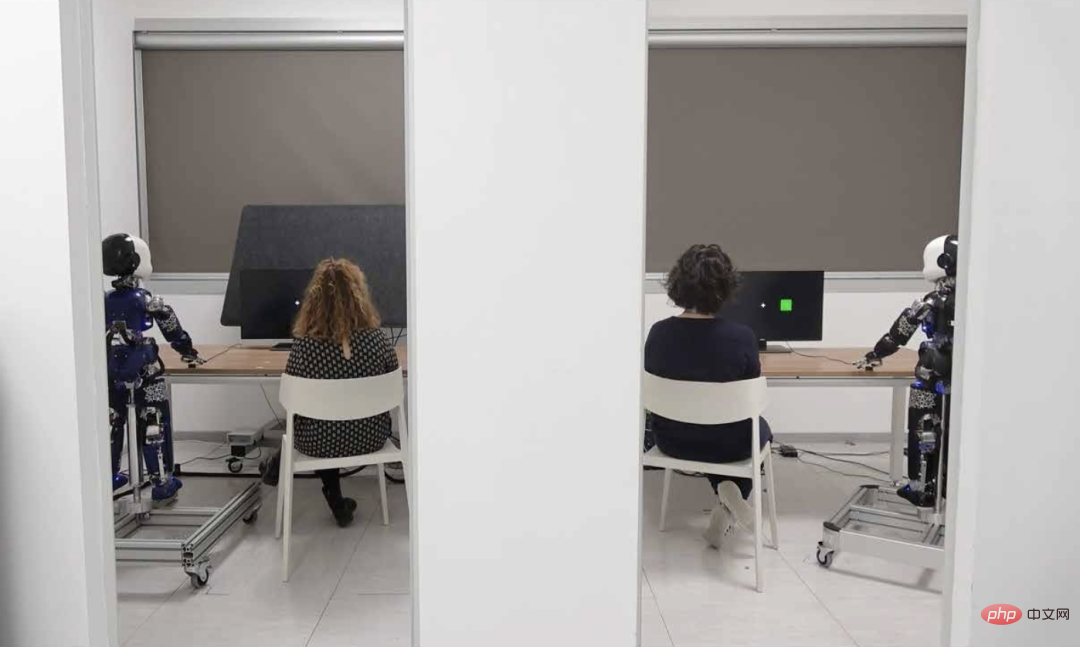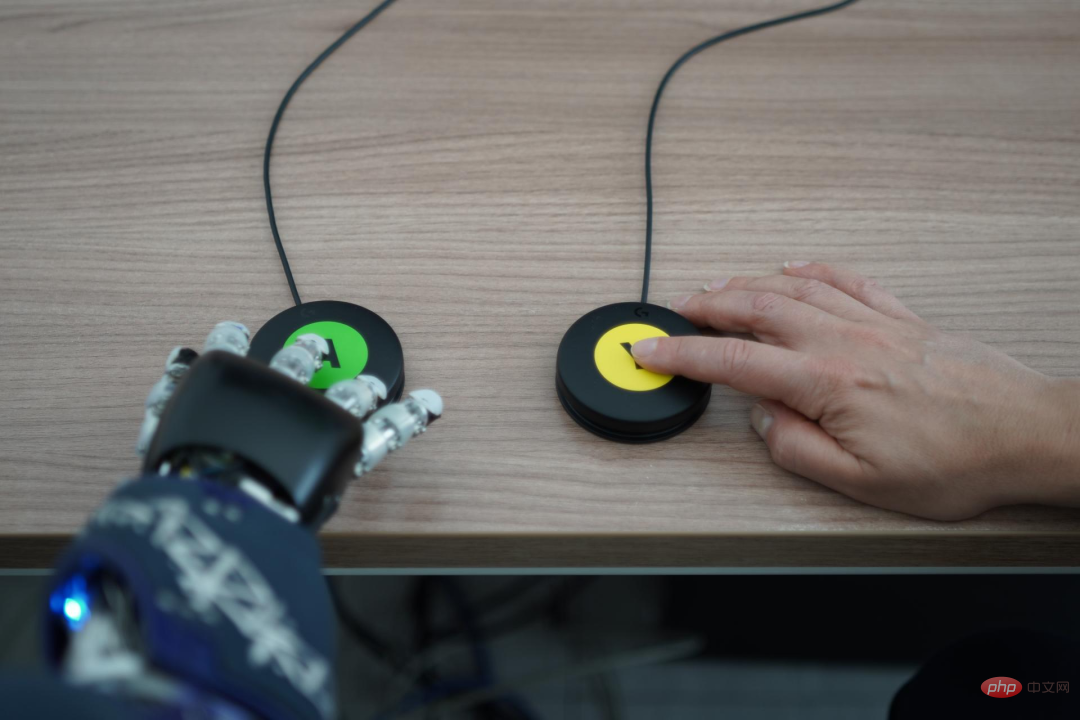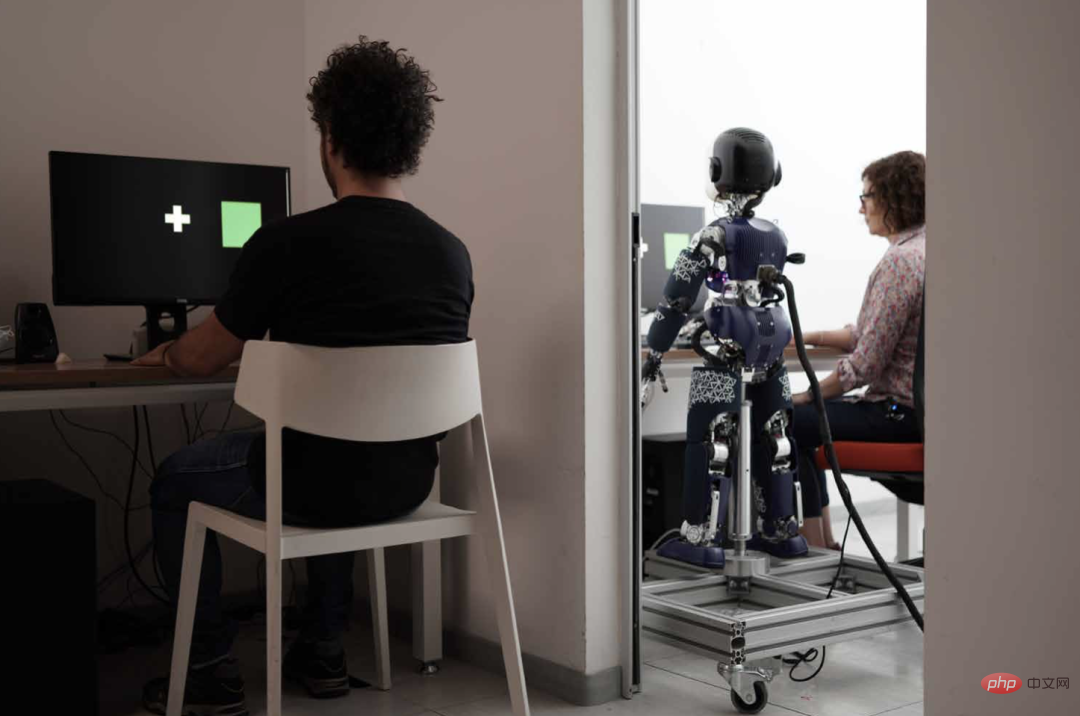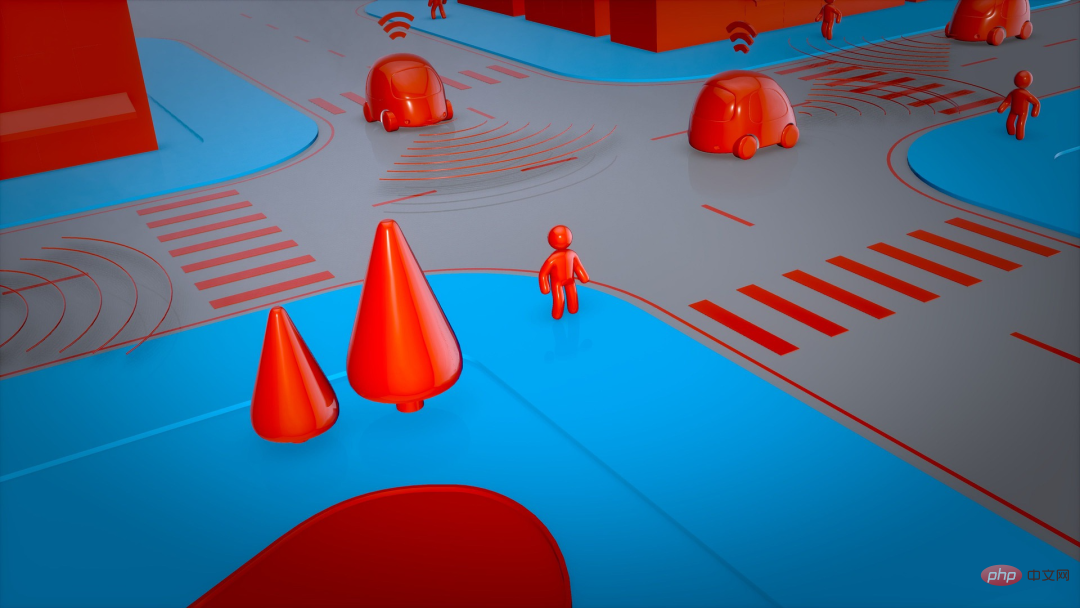Does artificial intelligence need to be like humans?
Can machines think? Can artificial intelligence be as smart as humans?
A new study shows that artificial intelligence may be able to do it.
In a non-linguistic Turing test, a research team led by Professor Agnieszka Wykowska of the Italian Institute of Technology found that human-like behavioral variability (Behavioral variability) can blur the distinction between humans and machines, that is, it can Helping robots look more like humans.
Specifically, their artificial intelligence program passed the nonverbal Turing test by simulating behavioral variability in human reaction times while playing games about matching shapes and colors with human teammates.
The related research paper is titled "Human-like behavioral variability blurs the distinction between a human and a machine in a nonverbal Turing test" and has been published in the scientific journal Science Robotics.
The research team stated that this work can provide guidance for future robot design, giving robots human-like behaviors that humans can perceive.
Regarding this research, Linköping University cognitive systems professor Tom Ziemke and postdoctoral researcher Sam Thellman believe that the research results "blur the difference between humans and machines" and provide a scientific understanding of human social cognition. Made very valuable contributions in other aspects.
However, "Human similarity is not necessarily the ideal goal for the development of artificial intelligence and robotics, and making artificial intelligence less like humans may be a smarter approach."
Through the picture In 1950, Alan Turing, the "father of computer science and artificial intelligence", proposed a test method to determine whether a machine is intelligent, the Turing test.
The key idea of the Turing Test is that complex questions about the possibility of machine thinking and intelligence can be verified by testing whether humans can tell whether they are interacting with another human or a machine.
Today, the Turing Test is used by scientists to evaluate what behavioral characteristics should be implemented in artificial agents to make it impossible for humans to distinguish computer programs from human behavior.
Herbert Simon, the pioneer of artificial intelligence, once said: "If the behavior displayed by the program is similar to that displayed by humans, then we call them intelligent." Similarly, Elaine Rich described artificial intelligence as Intelligence is defined as “the study of how to make computers do things that humans currently do better.”
The non-verbal Turing test is a form of Turing test. Passing the non-verbal Turing test is not easy for artificial intelligence, as they are not as adept as humans at detecting and distinguishing subtle behavioral characteristics of other people (objects).
So, can a humanoid robot pass the non-verbal Turing test and embody human characteristics in its physical behavior? In the non-verbal Turing test, the research team sought to see whether an AI could be programmed to vary its reaction times within a range similar to human behavioral variation, and thus be considered human.
To do this, they placed humans and robots in a room with different colors and shapes on the screen.

 Participants pressed a button when the shape or color changed, and the robot responded to this signal by clicking on the opposite color or shape displayed on the screen.
Participants pressed a button when the shape or color changed, and the robot responded to this signal by clicking on the opposite color or shape displayed on the screen.

 During testing, the robot was sometimes controlled remotely by humans, Sometimes controlled by artificial intelligence trained to mimic behavioral variability.
During testing, the robot was sometimes controlled remotely by humans, Sometimes controlled by artificial intelligence trained to mimic behavioral variability.
 Picture | Participants were asked to judge whether the robot's behavior was pre-programmed or controlled by a human. (Source: The paper)
Picture | Participants were asked to judge whether the robot's behavior was pre-programmed or controlled by a human. (Source: The paper)
The results showed that participants could easily tell when the robot was being operated by another person.
However, when the robot was operated by artificial intelligence, the probability of participants guessing incorrectly exceeded 50%.
Figure|Average accuracy of Turing test. (Source: The paper)
This means that their artificial intelligence passed the non-verbal Turing test.
However, the researchers also suggest that variability in human-like behavior may only be a necessary and insufficient condition for passing the non-verbal Turing test of entity artificial intelligence, since it can also manifest itself in human environments.
Does artificial intelligence need to be like humans?
Artificial intelligence research has long targeted human similarity as a goal and metric, and Wykowska’s team’s research demonstrates that behavioral variability may be used to make robots more like humans.
Ziemke and others believe that making artificial intelligence less like humans may be a wiser approach, and elaborated on the two cases of self-driving cars and chat robots.
For example, when you are about to cross a crosswalk on the road and see a car approaching you, from a distance, you may not be able to tell whether it is a self-driving car, so you can only Judging by the car's behavior.

(Source: Pixabay)
However, even if you see someone sitting in front of the steering wheel, you cannot be sure that this person is actively controlling the vehicle. Or is it just monitoring the driving operation of the vehicle.
"This has a very important impact on traffic safety. If a self-driving car cannot indicate to others whether it is in self-driving mode, it may lead to unsafe human-machine interactions."
Maybe some people would say that ideally, you don't need to know whether a car is self-driving, because in the long run, self-driving cars may be better at driving than humans. However, for now, people’s trust in self-driving cars is far from enough.
The chatbot is closer to the real-life scenario of Turing’s original test. Many companies use chatbots in their online customer service, where conversation topics and interaction options are relatively limited. In this context, chatbots are often more or less indistinguishable from humans.

(Source: Pixabay)
So, the question is, should companies tell customers about the non-human status of chatbots? Once told, it often leads to negative reactions from consumers, such as a decrease in trust.
As the above cases illustrate, while human-like behavior may be an impressive achievement from an engineering perspective, the indistinguishability of humans and machines brings significant Psychological, ethical and legal issues.
On the one hand, people interacting with these systems must know the nature of what they are interacting with to avoid deception. Taking chatbots as an example, California in the United States has enacted a chatbot information disclosure law since 2018, making it clear that disclosure is a strict requirement.
On the other hand, there are examples where chatbots and human customer service agents are even more indistinguishable. For example, when it comes to self-driving, interactions between self-driving cars and other road users don't have the same clear start and end points, they're often not one-to-one, and they have certain real-time constraints.
So the question is when and how should the identity and capabilities of self-driving cars be communicated.
Furthermore, fully automated cars may still be decades away. Therefore, mixed traffic and varying degrees of partial automation are likely to be a reality for the foreseeable future.
There has been a lot of research on what external interfaces self-driving cars might need to communicate with people. However, little is known about the complexities that vulnerable road users such as children and people with disabilities are actually able and willing to cope with.
Thus, the above general rule that "persons interacting with such a system must be informed of the nature of the objects to be interacted with" may only be possible to follow under more explicit circumstances.
Similarly, this ambivalence is reflected in discussions of social robotics research: Given humans’ tendency to anthropomorphize mental states and assign them human-like attributes, many researchers aim to make robots look and behave the same. more human-like so that they can interact in a more or less human-like manner.
However, others argue that robots should be easily identifiable as machines to avoid overly anthropomorphic attributes and unrealistic expectations.
"So it may be wiser to use these findings to make robots less human-like." In the early days of artificial intelligence, imitating humans may have been a common goal in the industry, "but as artificial intelligence has Today, as it has become a part of people's daily lives, we need to at least think about the direction in which we should strive to achieve human-like artificial intelligence."
The above is the detailed content of Does artificial intelligence need to be like humans?. For more information, please follow other related articles on the PHP Chinese website!

Hot AI Tools

Undresser.AI Undress
AI-powered app for creating realistic nude photos

AI Clothes Remover
Online AI tool for removing clothes from photos.

Undress AI Tool
Undress images for free

Clothoff.io
AI clothes remover

AI Hentai Generator
Generate AI Hentai for free.

Hot Article

Hot Tools

Notepad++7.3.1
Easy-to-use and free code editor

SublimeText3 Chinese version
Chinese version, very easy to use

Zend Studio 13.0.1
Powerful PHP integrated development environment

Dreamweaver CS6
Visual web development tools

SublimeText3 Mac version
God-level code editing software (SublimeText3)

Hot Topics
 Bytedance Cutting launches SVIP super membership: 499 yuan for continuous annual subscription, providing a variety of AI functions
Jun 28, 2024 am 03:51 AM
Bytedance Cutting launches SVIP super membership: 499 yuan for continuous annual subscription, providing a variety of AI functions
Jun 28, 2024 am 03:51 AM
This site reported on June 27 that Jianying is a video editing software developed by FaceMeng Technology, a subsidiary of ByteDance. It relies on the Douyin platform and basically produces short video content for users of the platform. It is compatible with iOS, Android, and Windows. , MacOS and other operating systems. Jianying officially announced the upgrade of its membership system and launched a new SVIP, which includes a variety of AI black technologies, such as intelligent translation, intelligent highlighting, intelligent packaging, digital human synthesis, etc. In terms of price, the monthly fee for clipping SVIP is 79 yuan, the annual fee is 599 yuan (note on this site: equivalent to 49.9 yuan per month), the continuous monthly subscription is 59 yuan per month, and the continuous annual subscription is 499 yuan per year (equivalent to 41.6 yuan per month) . In addition, the cut official also stated that in order to improve the user experience, those who have subscribed to the original VIP
 Context-augmented AI coding assistant using Rag and Sem-Rag
Jun 10, 2024 am 11:08 AM
Context-augmented AI coding assistant using Rag and Sem-Rag
Jun 10, 2024 am 11:08 AM
Improve developer productivity, efficiency, and accuracy by incorporating retrieval-enhanced generation and semantic memory into AI coding assistants. Translated from EnhancingAICodingAssistantswithContextUsingRAGandSEM-RAG, author JanakiramMSV. While basic AI programming assistants are naturally helpful, they often fail to provide the most relevant and correct code suggestions because they rely on a general understanding of the software language and the most common patterns of writing software. The code generated by these coding assistants is suitable for solving the problems they are responsible for solving, but often does not conform to the coding standards, conventions and styles of the individual teams. This often results in suggestions that need to be modified or refined in order for the code to be accepted into the application
 Seven Cool GenAI & LLM Technical Interview Questions
Jun 07, 2024 am 10:06 AM
Seven Cool GenAI & LLM Technical Interview Questions
Jun 07, 2024 am 10:06 AM
To learn more about AIGC, please visit: 51CTOAI.x Community https://www.51cto.com/aigc/Translator|Jingyan Reviewer|Chonglou is different from the traditional question bank that can be seen everywhere on the Internet. These questions It requires thinking outside the box. Large Language Models (LLMs) are increasingly important in the fields of data science, generative artificial intelligence (GenAI), and artificial intelligence. These complex algorithms enhance human skills and drive efficiency and innovation in many industries, becoming the key for companies to remain competitive. LLM has a wide range of applications. It can be used in fields such as natural language processing, text generation, speech recognition and recommendation systems. By learning from large amounts of data, LLM is able to generate text
 Can fine-tuning really allow LLM to learn new things: introducing new knowledge may make the model produce more hallucinations
Jun 11, 2024 pm 03:57 PM
Can fine-tuning really allow LLM to learn new things: introducing new knowledge may make the model produce more hallucinations
Jun 11, 2024 pm 03:57 PM
Large Language Models (LLMs) are trained on huge text databases, where they acquire large amounts of real-world knowledge. This knowledge is embedded into their parameters and can then be used when needed. The knowledge of these models is "reified" at the end of training. At the end of pre-training, the model actually stops learning. Align or fine-tune the model to learn how to leverage this knowledge and respond more naturally to user questions. But sometimes model knowledge is not enough, and although the model can access external content through RAG, it is considered beneficial to adapt the model to new domains through fine-tuning. This fine-tuning is performed using input from human annotators or other LLM creations, where the model encounters additional real-world knowledge and integrates it
 To provide a new scientific and complex question answering benchmark and evaluation system for large models, UNSW, Argonne, University of Chicago and other institutions jointly launched the SciQAG framework
Jul 25, 2024 am 06:42 AM
To provide a new scientific and complex question answering benchmark and evaluation system for large models, UNSW, Argonne, University of Chicago and other institutions jointly launched the SciQAG framework
Jul 25, 2024 am 06:42 AM
Editor |ScienceAI Question Answering (QA) data set plays a vital role in promoting natural language processing (NLP) research. High-quality QA data sets can not only be used to fine-tune models, but also effectively evaluate the capabilities of large language models (LLM), especially the ability to understand and reason about scientific knowledge. Although there are currently many scientific QA data sets covering medicine, chemistry, biology and other fields, these data sets still have some shortcomings. First, the data form is relatively simple, most of which are multiple-choice questions. They are easy to evaluate, but limit the model's answer selection range and cannot fully test the model's ability to answer scientific questions. In contrast, open-ended Q&A
 SOTA performance, Xiamen multi-modal protein-ligand affinity prediction AI method, combines molecular surface information for the first time
Jul 17, 2024 pm 06:37 PM
SOTA performance, Xiamen multi-modal protein-ligand affinity prediction AI method, combines molecular surface information for the first time
Jul 17, 2024 pm 06:37 PM
Editor | KX In the field of drug research and development, accurately and effectively predicting the binding affinity of proteins and ligands is crucial for drug screening and optimization. However, current studies do not take into account the important role of molecular surface information in protein-ligand interactions. Based on this, researchers from Xiamen University proposed a novel multi-modal feature extraction (MFE) framework, which for the first time combines information on protein surface, 3D structure and sequence, and uses a cross-attention mechanism to compare different modalities. feature alignment. Experimental results demonstrate that this method achieves state-of-the-art performance in predicting protein-ligand binding affinities. Furthermore, ablation studies demonstrate the effectiveness and necessity of protein surface information and multimodal feature alignment within this framework. Related research begins with "S
 Five schools of machine learning you don't know about
Jun 05, 2024 pm 08:51 PM
Five schools of machine learning you don't know about
Jun 05, 2024 pm 08:51 PM
Machine learning is an important branch of artificial intelligence that gives computers the ability to learn from data and improve their capabilities without being explicitly programmed. Machine learning has a wide range of applications in various fields, from image recognition and natural language processing to recommendation systems and fraud detection, and it is changing the way we live. There are many different methods and theories in the field of machine learning, among which the five most influential methods are called the "Five Schools of Machine Learning". The five major schools are the symbolic school, the connectionist school, the evolutionary school, the Bayesian school and the analogy school. 1. Symbolism, also known as symbolism, emphasizes the use of symbols for logical reasoning and expression of knowledge. This school of thought believes that learning is a process of reverse deduction, through existing
 SK Hynix will display new AI-related products on August 6: 12-layer HBM3E, 321-high NAND, etc.
Aug 01, 2024 pm 09:40 PM
SK Hynix will display new AI-related products on August 6: 12-layer HBM3E, 321-high NAND, etc.
Aug 01, 2024 pm 09:40 PM
According to news from this site on August 1, SK Hynix released a blog post today (August 1), announcing that it will attend the Global Semiconductor Memory Summit FMS2024 to be held in Santa Clara, California, USA from August 6 to 8, showcasing many new technologies. generation product. Introduction to the Future Memory and Storage Summit (FutureMemoryandStorage), formerly the Flash Memory Summit (FlashMemorySummit) mainly for NAND suppliers, in the context of increasing attention to artificial intelligence technology, this year was renamed the Future Memory and Storage Summit (FutureMemoryandStorage) to invite DRAM and storage vendors and many more players. New product SK hynix launched last year






